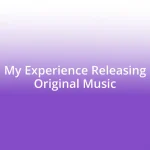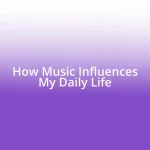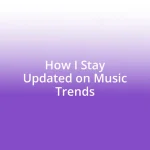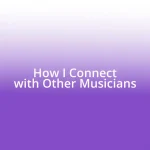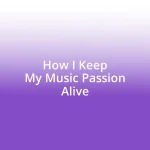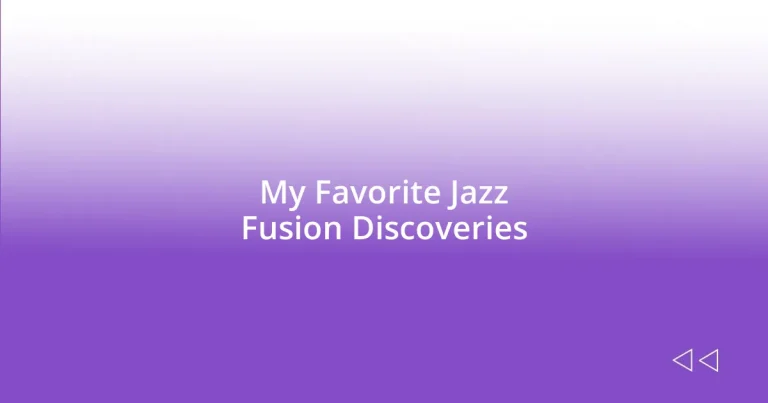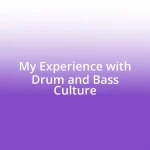Key takeaways:
- Jazz fusion blends jazz improvisation with elements from genres like rock, funk, and world music, allowing for rich creativity and emotional connection.
- Key artists in jazz fusion include Miles Davis, Herbie Hancock, and Pat Metheny, each known for their innovative contributions that expand the genre’s boundaries.
- Noteworthy albums such as “Bitches Brew” by Miles Davis and “Heavy Weather” by Weather Report exemplify the genre’s complexity and emotional depth.
- Jazz fusion serves as a platform for exploration and personal reflection, inviting listeners to engage deeply with the music and its diverse influences.
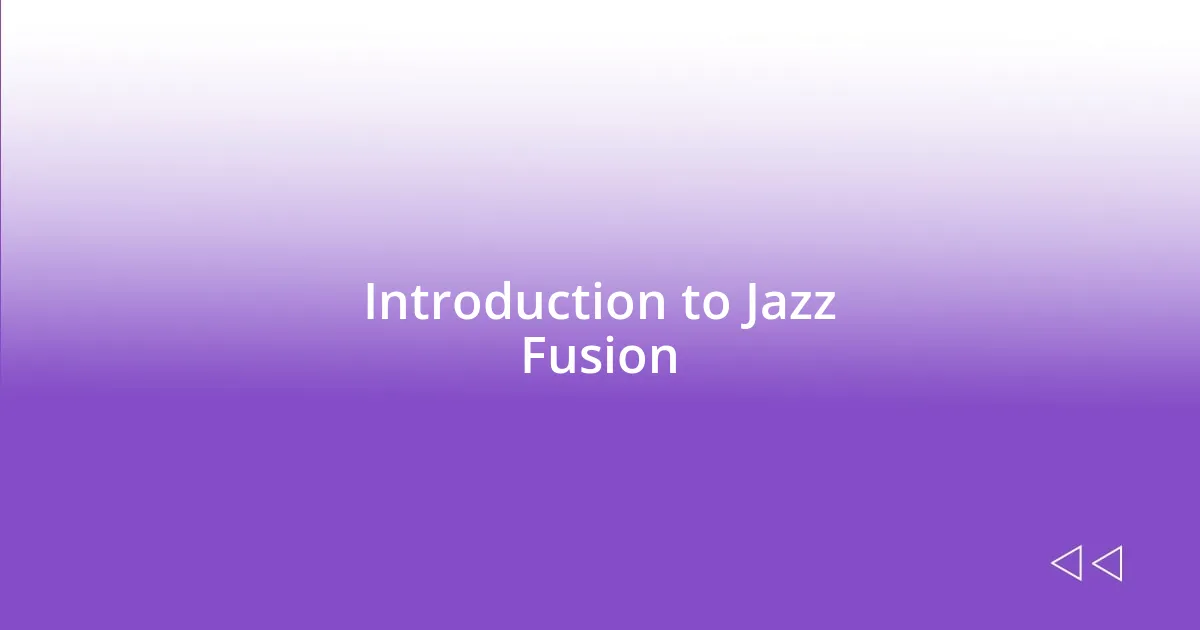
Introduction to Jazz Fusion
Jazz fusion represents a thrilling crossroads of musical styles, blending the improvisational spirit of jazz with the rhythmic and harmonic aspects of other genres, such as rock, funk, and world music. I still vividly remember the first time I heard a fusion piece; it was as if the music unlocked a hidden door to new soundscapes I had yet to explore. Can you recall a moment when a song completely changed your perception of music?
What I love about jazz fusion is its boundless creativity. Artists are free to experiment, combining complex melodies with electric instrumentation, resulting in compositions that push boundaries and challenge conventions. I often find myself drawn to the energy of these tracks, tapping my foot or nodding my head along to the vibrant rhythms, which makes me wonder—how can a genre so diverse feel like home to so many listeners?
In essence, jazz fusion is about exploration and connection. It invites musicians and listeners alike to engage with a rich tapestry of influences and emotions. When I immerse myself in a compelling fusion piece, I feel like I’m part of an ongoing conversation, always evolving and inviting new perspectives. Isn’t that what we all seek in music—an experience that resonates on a personal level?
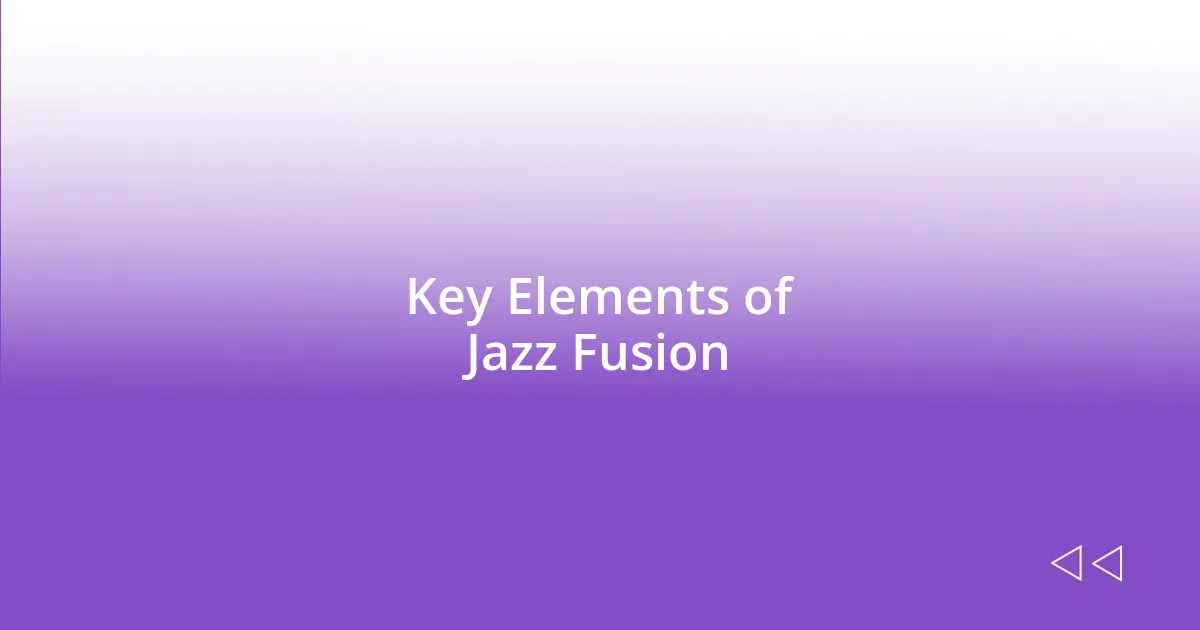
Key Elements of Jazz Fusion
Jazz fusion is defined by several key elements that set it apart from traditional jazz. One of the most striking aspects is the use of electric instruments, which evokes a vibrant and modern feel. I remember listening to a Mahavishnu Orchestra track for the first time, and the electric guitar distorted with a jazz sensibility completely blew my mind. The rhythmic complexity combined with rock influences engages you in a way that feels both energetic and introspective.
Here are some core elements that shape the essence of jazz fusion:
- Improvisation: Musicians often break from traditional forms, allowing for spontaneous creativity.
- Electric Instruments: Guitars, keyboards, and synthesizers create a rich, textured soundscape.
- Rhythmic Diversity: Complex time signatures and polyrhythms pull influences from funk, rock, and world music.
- Melodic Complexity: The interaction between intricate melodies and harmony showcases technical musicianship.
- Genre Blending: The fusion of different styles invites a broad array of musical influences.
Encountering jazz fusion feels like uncovering layers of a complex mural; each listen reveals something new. The seamless integration of genres speaks to my passion for music that resonates emotionally while challenging my listening skills. Sometimes, I find myself lost in thought about how these artists dare to break rules, reminding me of the importance of creativity in any art form.
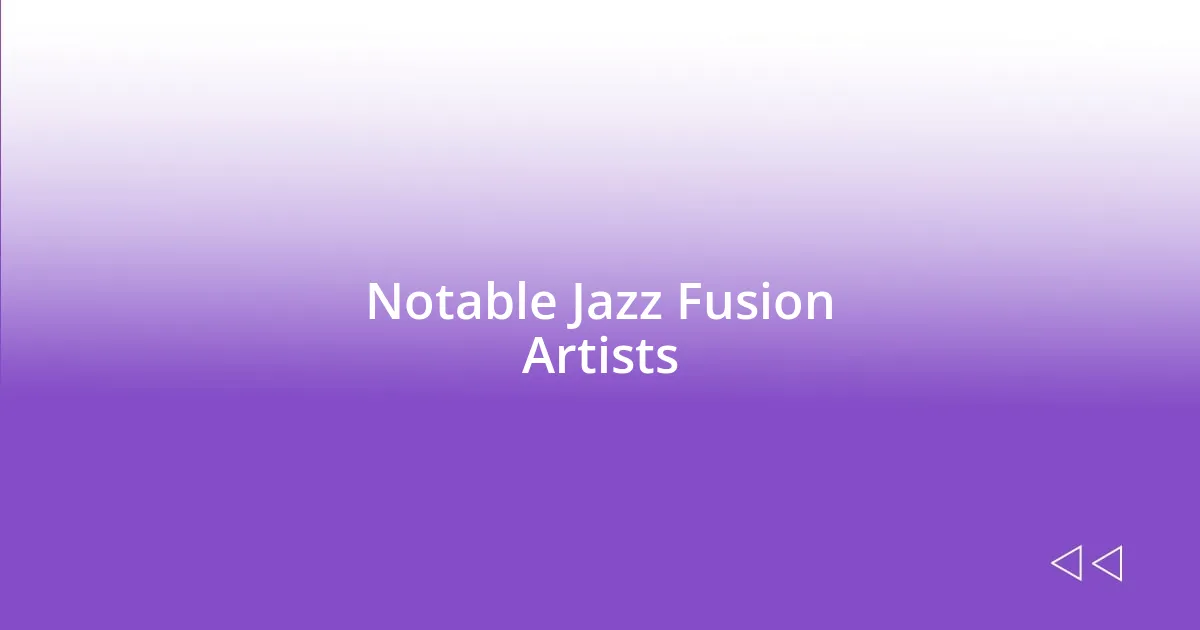
Notable Jazz Fusion Artists
When considering notable jazz fusion artists, I immediately think of names like Miles Davis and Herbie Hancock. Miles, with his groundbreaking album “Bitches Brew,” crafted a sound that set the stage for the genre itself. I still remember sitting in my living room, headphones on, and feeling transported through the swirling beats and improvisational brilliance. It made me appreciate how jazz could evolve and adapt, breaking down barriers of tradition.
Herbie Hancock is another titan in the world of jazz fusion. His ability to blend funk grooves with jazz improvisation is simply unmatched. I can picture experiencing his track “Chameleon” for the first time; the catchy bassline was infectious, making me want to dance while simultaneously marveling at the intricate piano solos weaving in and out. It’s this kind of dynamic interplay that pulls listeners in, keeping us on our toes as we navigate the complexity of these compositions.
Pat Metheny, with his unique guitar style, is a true innovator in the fusion scene. I recall a night at a local jazz club where he played a live set that resonated deeply with me. The way he effortlessly moved through varied tempos and textures felt like a conversation between friends, each note rich with emotion and intention. It’s artists like him who remind me why I cherish jazz fusion; it’s a genre that doesn’t just entertain but also invites reflection and connection.
| Artist | Notable Work |
|---|---|
| Miles Davis | Bitches Brew |
| Herbie Hancock | Chameleon |
| Pat Metheny | Secret Story |
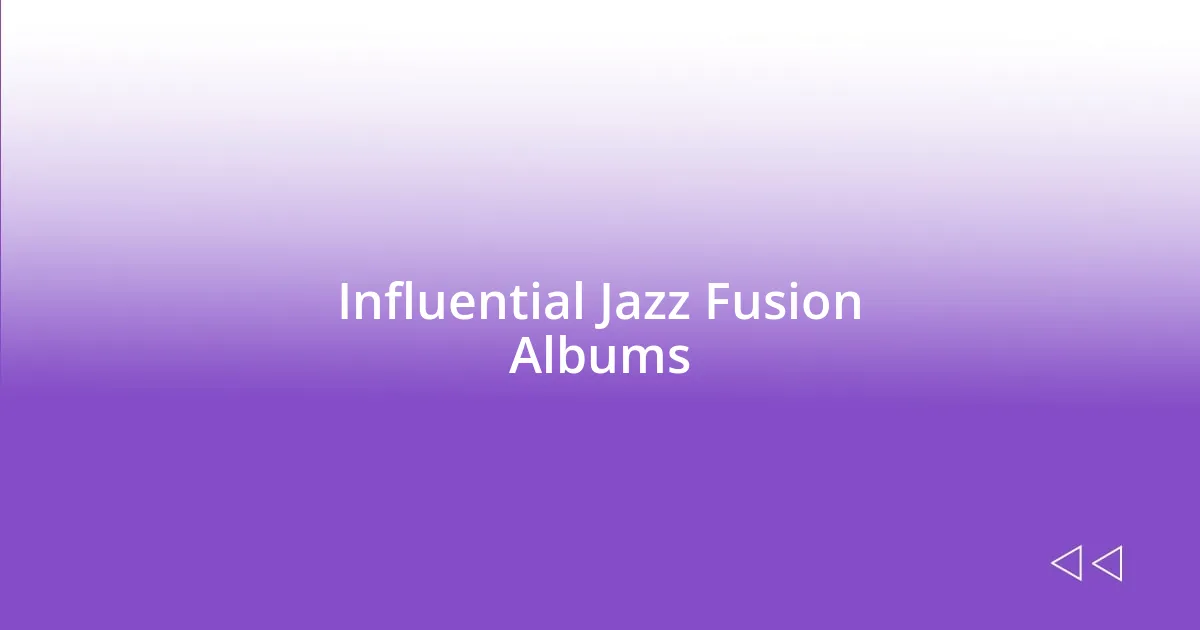
Influential Jazz Fusion Albums
One album that truly stands out in the jazz fusion genre is Weather Report’s “Heavy Weather.” I can still vividly remember the day I stumbled upon it in a record store. The moment “Birdland” hit my ears, I felt an exhilarating rush—the layers of sound, the interplay of instruments, and Joe Zawinul’s lush keyboards created a sonic tapestry that was both exhilarating and serene. Does music get any better than this? It’s a perfect example of how jazz fusion can transport you to different emotional landscapes while keeping you engrossed in the moment.
Chick Corea’s “Return to Forever” is another album that had a profound impact on my understanding of fusion. I recall diving into it during a quiet afternoon; the mixture of Latin rhythms and electric improvisation just captivated me. The opening track, filled with intricate melodies and a pulse that beckoned me to groove, left me questioning how one artist could fuse such diverse influences so seamlessly. It reminded me that jazz is not just about technical prowess but also about evoking feelings and memories, painting vivid pictures through music.
Lastly, let’s not forget about “The Inner Mounting Flame” by Mahavishnu Orchestra. I first got lost in its intricate compositions while learning about music theory, and every note felt like it was challenging my understanding of rhythm and melody. The powerful blend of rock energy with jazz improvisation created a thrilling atmosphere. I still ask myself, how do they manage to convey such emotion through complex time signatures? It’s that very question that keeps me coming back to these albums, eager to uncover more layers and learn from the masters of jazz fusion.
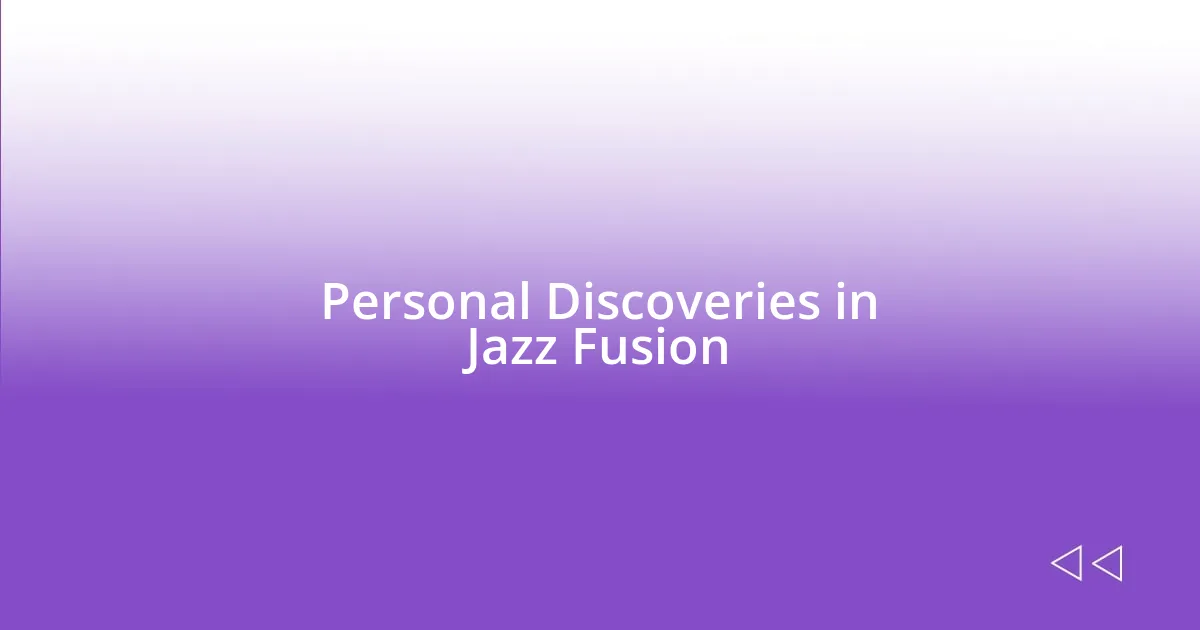
Personal Discoveries in Jazz Fusion
The realm of jazz fusion has led me to some unexpected yet delightful musical finds. One night, while browsing a friend’s vinyl collection, I stumbled upon “Bright Size Life” by Pat Metheny. I vividly remember the first track playing in the background while we shared stories. The intricate interplay between Metheny’s guitar and Jaco Pastorius’ bass was mesmerizing. It created a dialogue that felt intimate yet expansive; I found myself lost in thought, contemplating how sound can cultivate such deep connections among listeners.
Another significant discovery for me has been Snarky Puppy, a band that beautifully bridges genres with their innovative sound. I recall attending a live performance, and as the first notes washed over the crowd, we were all drawn together in a shared experience. Each song felt like a journey, evoking a range of emotions from joy to introspection. I couldn’t help but marvel at how they effortlessly blended elements of funk, jazz, and world music. Have you ever felt that rush of energy in a live setting, where it seems everyone is on the same wavelength? It’s moments like these that reinforce why I’m so passionate about jazz fusion.
Exploring the works of musicians like Eberhard Weber has deepened my appreciation for the genre. Upon listening to his album “The Colours of Chloë,” I was struck not just by the music itself, but by how it feels like an emotional narrative. I remember sitting on a park bench, letting the sounds envelop me while watching the leaves dance in the wind. Each track created an atmosphere that stirred memories and dreams alike, highlighting how powerful music can be as a storytelling medium. Isn’t it fascinating how one piece of music can transport you to another time and place, making you reflect on your own journey?
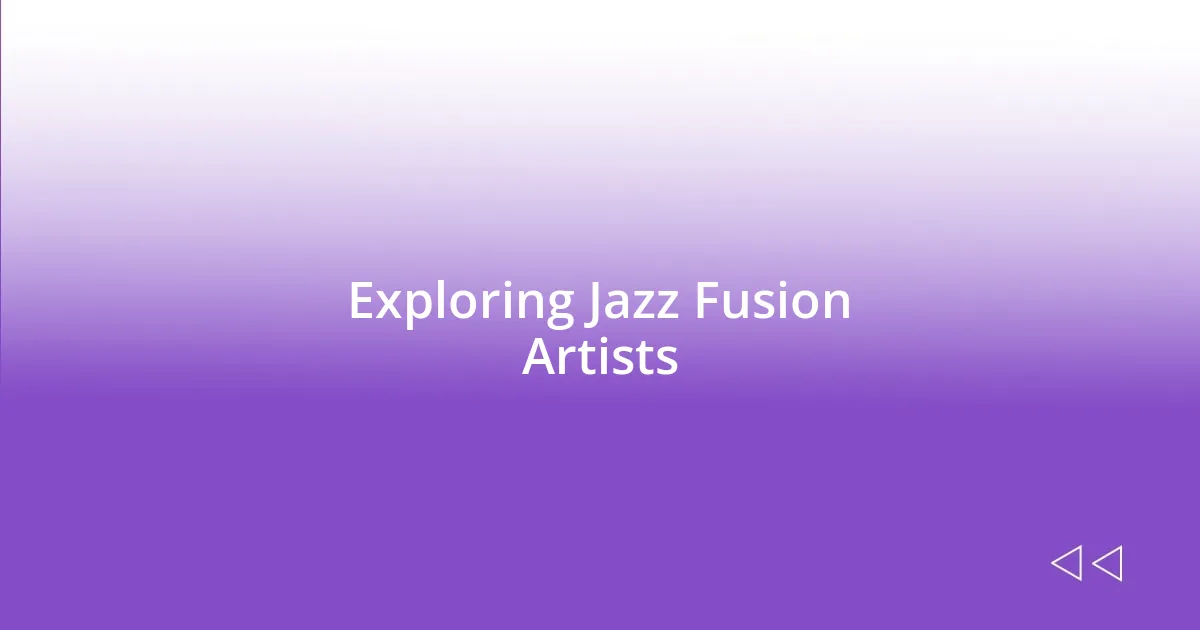
Exploring Jazz Fusion Artists
Jazz fusion is a treasure trove of artistic minds, and one of the artists who has left a lasting impression on me is Herbie Hancock. I recall a rainy Sunday morning when I first heard “Head Hunters.” The infectious groove of “Chameleon” had me tapping my feet almost instinctively. Hancock’s ability to blend jazz with funk was a revelation for me; it was as if he was crafting a musical bridge between two worlds that usually stayed apart. Have you ever experienced that moment when a song feels like a long-lost friend? For me, Hancock became just that.
Delving into the work of artists like Return to Forever led me to explore not only their rich compositions but also the band members’ individual projects. I vividly remember being captivated by Al Di Meola’s “Elegant Gypsy.” The moment I heard the opening track, I felt myself whisked away to a Mediterranean landscape. Di Meola’s guitar playing is nothing short of a vivid painting of emotions and scenery, showcasing how one instrument can evoke such depth. Isn’t it incredible how a single song can transport us to places we’ve never been?
I’ve also been inspired by the sonic adventures of keyboardist Joe Zawinul, particularly in his own projects. I distinctly remember a late-night session where I discovered “Zawinul.” The first time I listened to “The Harvest,” I was completely entranced by its hypnotic blend of world music influences with complex jazz elements. It felt both intimate and expansive, almost like a conversation with the universe itself. How often do we find music that resonates with us on such a profound level? Moments like these remind me of the power of jazz fusion to connect us to something greater than our everyday lives.
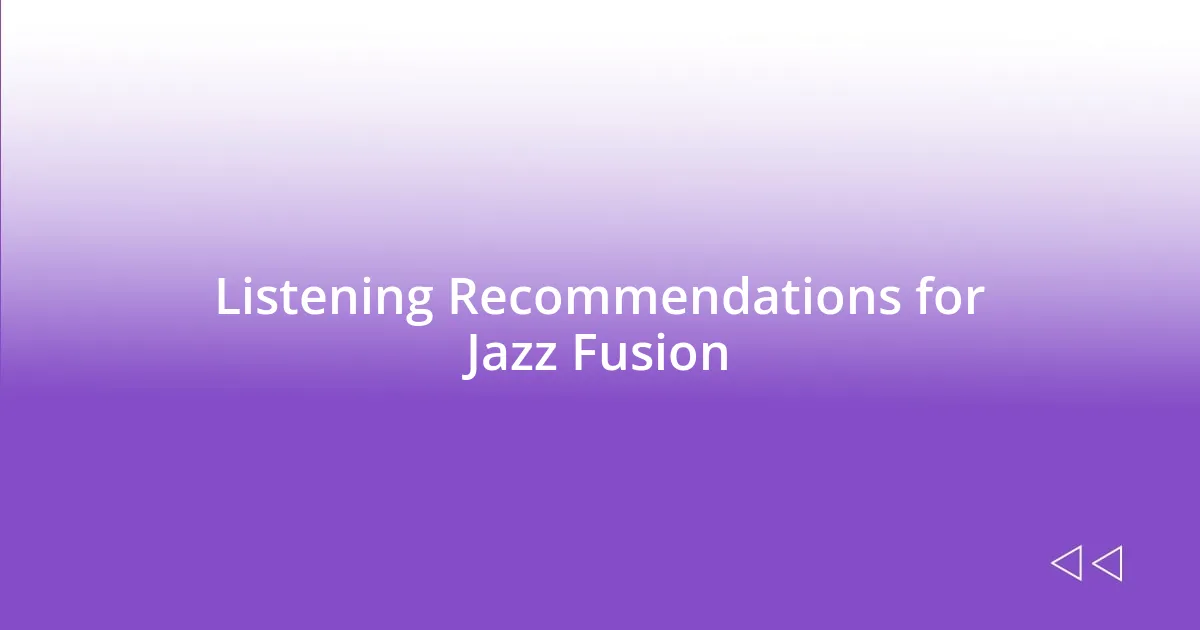
Listening Recommendations for Jazz Fusion
When it comes to listening recommendations for jazz fusion, one of my all-time favorites is “Bitches Brew” by Miles Davis. I vividly remember introducing this album to a group of friends during a sunset gathering. As the experimental sounds unfolded, I observed how everyone responded differently, each listener lost in their thoughts yet united in the experience. It’s incredible how a complex album can ignite such varied emotions and thoughts—have you ever felt like music helped you discover a new perspective?
Another recommendation I swear by is “Lateralus” by Tool, which artfully blends heavy rock influences with jazz elements. I stumbled upon this gem while searching for something different to accompany my late-night sketching sessions. The intricate drumming echoed my pencil strokes, and I felt the music pushing and pulling me in a rhythm of its own. It prompted me to ask myself: how often can rock and jazz coexist in such a seamless way? This intersection is where jazz fusion truly shines, offering something fresh at every listen.
Don’t overlook the craftsmanship of “Goodbye Tangerine” by the band Tortoise. I discovered this album during a quiet afternoon when I wanted something melodic yet instrumental. The gentle, laid-back grooves instantly set a serene mood in my space. I found myself closing my eyes and simply drifting away with the sound—have you ever had a moment when music wraps around you like a warm blanket? Tortoise is an excellent reminder of how jazz fusion can create a sanctuary, inviting listeners to relax and lose themselves in its layers.




